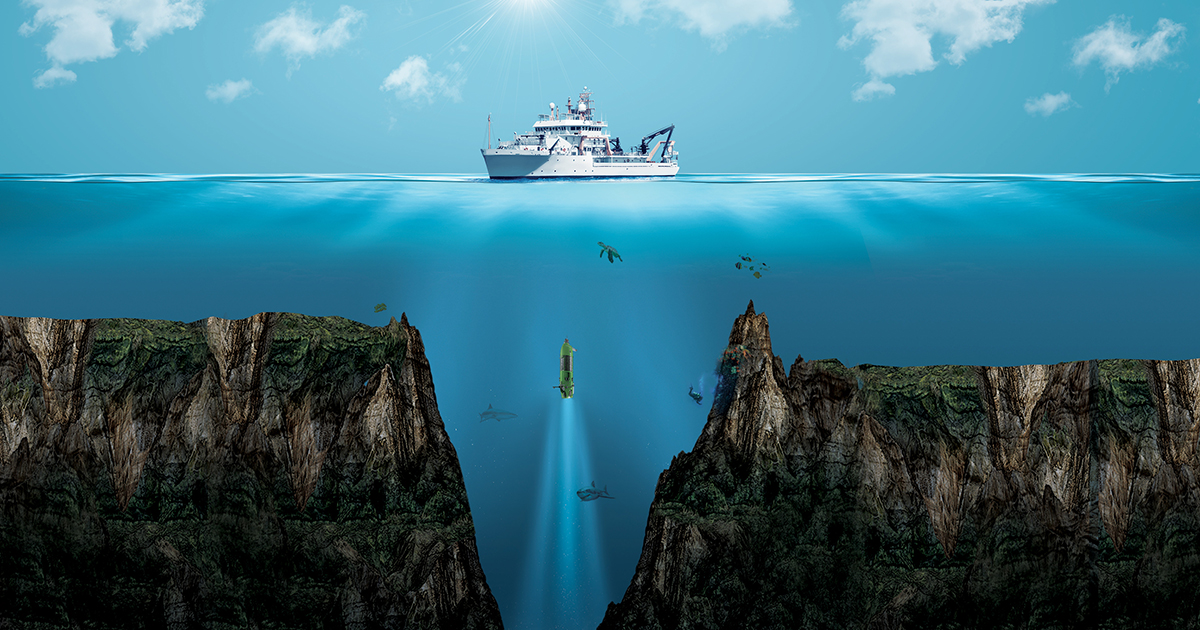The Mariana Trench
The Mariana Trench is one of Earth's most enigmatic and profound natural wonders.
Located in the western Pacific Ocean, this crescent-shaped trench is the deepest part of the world's oceans. Its significance extends beyond its sheer depth, playing a crucial role in marine science, geology, and exploration.
Geographical Location
The Mariana Trench stretches east of the Mariana Islands, near Guam. It spans over 2,550 kilometers long and has a mean width of 69 kilometers.
The trench's closest point to the surface is known as the Challenger Deep, situated about 11,034 meters (36,201 feet) below sea level.
Historical Context
 William Frederick Mitchell, , Wikimedia Commons
William Frederick Mitchell, , Wikimedia Commons
The Mariana Trench was first discovered during the HMS Challenger expedition in 1875. The Challenger Deep, its deepest point, was named after this British Royal Navy ship.
This discovery marked a significant milestone in oceanographic science, opening up new avenues for deep-sea exploration.
Geological Significance
Geologically, the Mariana Trench is a subduction zone, where the Pacific Plate is being subducted beneath the smaller Mariana Plate.
This process is fundamental to understanding plate tectonics, earthquakes, and volcanic activity.
Biodiversity in the Depths
 NOAA Okeanos Explorer, Wikimedia Commons
NOAA Okeanos Explorer, Wikimedia Commons
Despite the extreme conditions, the Mariana Trench harbors a diverse range of life forms. Organisms like amphipods, small crustaceans, and even microbial life thrive in this high-pressure environment, offering insights into the adaptability of life.
Image: Deep-sea anemone Isactinernus observed by the NOAA Okeanos Explorer mission in the Mariana Trench.
Exploration Milestones
 Unknown author, Wikimedia Commons
Unknown author, Wikimedia Commons
Human exploration of the Mariana Trench began in earnest on 23 January 1960 when the Bathyscaphe Trieste, a deep-diving submersible, reached a record maximum depth of about 10,911 metres (35,797 ft), in the first descent of the Challenger Deep, in the Mariana Trench.
This was followed by several missions, including filmmaker James Cameron's solo dive in 2012, which highlighted the trench's accessibility for research and exploration.
Exploring the Mariana Trench requires advanced technology. Submersibles and remotely operated vehicles (ROVs) used for these expeditions are equipped with features to withstand extreme pressure, low temperatures, and the dark environment of the deep sea.
Image: The Bathyscaphe Trieste in 1960
Environmental Challenges
The Mariana Trench faces environmental challenges, including the risk of pollution. Despite its remote location, evidence of human impact, such as plastic waste, has been found at its depths, raising concerns about the health of deep-sea ecosystems.
The Future of Mariana Trench Exploration
The future of exploration in the Mariana Trench looks promising, with advancements in technology and growing interest in deep-sea research.
Scientific research conducted in the Mariana Trench has led to significant discoveries about life in extreme environments, geological processes, and even clues about Earth's early conditions.
Each expedition brings new findings, contributing to our understanding of the deep ocean.
Ongoing exploration is expected to uncover more secrets lying in the depths of this mysterious underwater landscape.
Final Thoughts
The Mariana Trench is not just a geographical feature but a frontier of human exploration and scientific discovery.
Its exploration continues to challenge our understanding of the planet and inspires efforts to protect these uncharted ecosystems.
Image: Brittle Star from the Marianas Trench












